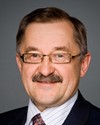In effect, when I looked at municipalities, every municipality has issues with waste water, water treatment plants, water pipelines, sewer lines, and their streets. Every community knows issues. One community may, on its own accord, build a water treatment plant at a million dollars. Then a program comes out and the sister community applies and gets one-third share from the federal government and one-third from the provincial government to build that same water treatment plant, or whatever it is.
You're addressing one municipality's problem but not the other's. The beauty of the gas tax fund is that you're giving the communities the opportunity to decide what needs to be done, but eventually you'll address the water treatment plant, the road, the sewer, the water line, and so on.
Wouldn't you agree that making the gas tax permanent and servicing a whole range of core services is a very direct and very positive way in addressing the infrastructure deficit, whatever it might be?



